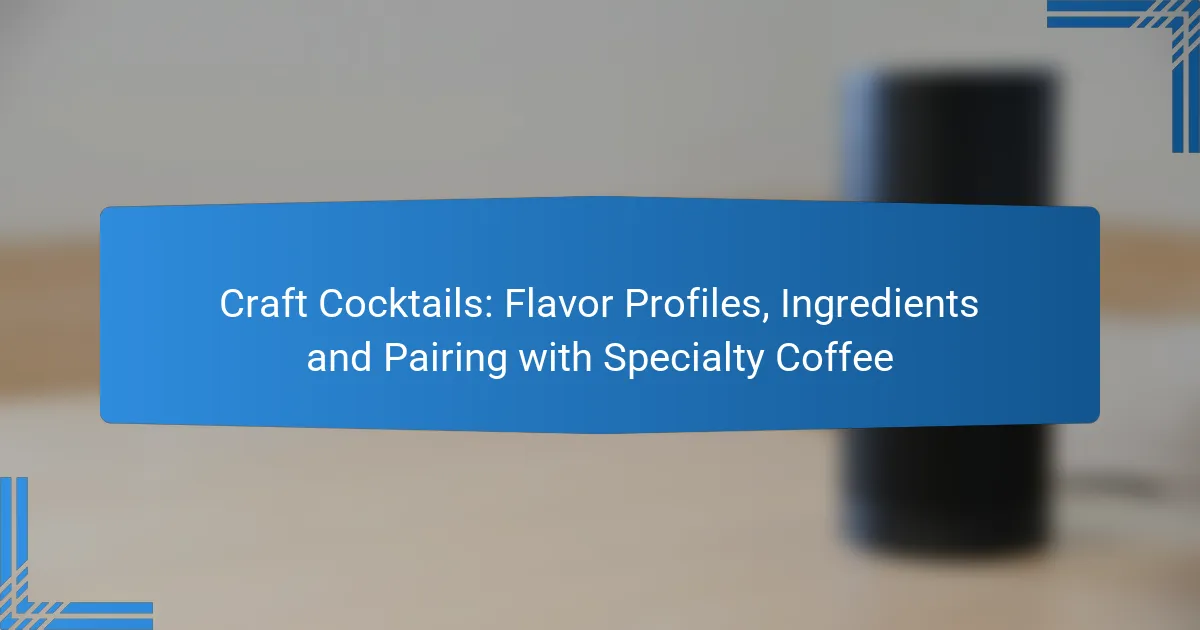Craft cocktails featuring specialty coffee offer a unique blend of rich flavors and aromas that elevate the drinking experience. By carefully selecting high-quality coffee and pairing it with complementary ingredients, you can create balanced drinks that cater to diverse palates. Exploring various flavor profiles—from sweet to spicy—allows for endless creativity in crafting the perfect coffee cocktail.

How to Craft Cocktails with Specialty Coffee?
Crafting cocktails with specialty coffee involves selecting high-quality coffee and pairing it with complementary flavors to create a balanced drink. Understanding the nuances of brewing methods and garnishing can elevate your cocktail experience.
Use high-quality coffee beans
The foundation of any coffee cocktail is the quality of the coffee beans used. Opt for freshly roasted, specialty-grade beans that offer unique flavor profiles. Look for beans with tasting notes that align with your cocktail’s theme, such as fruity, nutty, or chocolatey undertones.
Consider sourcing beans from local roasters or specialty shops that prioritize sustainability and ethical sourcing. This not only enhances flavor but also supports local economies.
Incorporate complementary flavors
Pairing coffee with flavors that enhance its natural characteristics is key to crafting a successful cocktail. Ingredients like vanilla, caramel, or citrus can complement the coffee’s richness and acidity. For instance, a coffee-infused Old Fashioned can benefit from a hint of orange zest.
Experiment with liqueurs, bitters, and syrups that harmonize with the coffee’s profile. For example, adding a splash of amaretto can bring out nutty notes, while a dash of chocolate bitters can deepen the drink’s complexity.
Experiment with brewing methods
The brewing method can significantly impact the flavor of your coffee cocktail. Techniques such as cold brew, espresso, or French press each impart different characteristics. Cold brew offers a smooth, less acidic base, while espresso provides a bold, concentrated flavor.
Try different brewing methods to see how they affect the overall taste of your cocktail. For instance, using a nitro cold brew can add a creamy texture without the need for dairy, making it a great choice for a lighter cocktail.
Balance sweetness and acidity
A successful coffee cocktail strikes a balance between sweetness and acidity. Too much sweetness can overpower the coffee’s flavor, while excessive acidity can make the drink unpleasant. Aim for a harmonious blend by adjusting the sweetness of your mixers and syrups.
As a guideline, start with a small amount of sweetener and gradually increase it to taste. Consider using natural sweeteners like honey or agave syrup, which can add depth without overwhelming the coffee’s profile.
Garnish for visual appeal
Garnishing your coffee cocktail not only enhances its visual appeal but can also add aromatic elements that elevate the drinking experience. Simple garnishes like coffee beans, citrus twists, or a sprinkle of cocoa can make your cocktail more inviting.
Be creative with your garnishes; consider using edible flowers or flavored whipped cream for a unique touch. A well-garnished cocktail can impress guests and make the drink more enjoyable.

What Are Popular Flavor Profiles for Coffee Cocktails?
Popular flavor profiles for coffee cocktails include a range of tastes that enhance the coffee experience. These profiles can be sweet, bold, citrusy, or spicy, each offering unique combinations that appeal to different palates.
Sweet and creamy
Sweet and creamy coffee cocktails often feature ingredients like cream, milk, or flavored syrups that complement the coffee’s natural bitterness. Common examples include Irish coffee with whipped cream and vanilla lattes with a splash of chocolate syrup.
When crafting these cocktails, consider balancing sweetness with the coffee’s richness. Using flavored liqueurs such as Kahlúa or Baileys can enhance the creamy texture while adding depth to the flavor.
Bold and bitter
Bold and bitter coffee cocktails emphasize the robust flavors of coffee, often using dark roasts or espresso as a base. Cocktails like the Espresso Martini or Black Russian highlight the coffee’s intensity, making them ideal for those who appreciate strong flavors.
To create a well-balanced bold cocktail, pair the coffee with spirits like vodka or rum, which can enhance the bitterness without overwhelming it. Avoid adding too much sweetness, as it can mask the coffee’s natural profile.
Citrusy and refreshing
Citrusy and refreshing coffee cocktails combine coffee with bright flavors, often using citrus juices or zests. Drinks like the Coffee Mojito or Citrus Cold Brew offer a lively twist on traditional coffee beverages, making them perfect for warm weather.
When crafting these cocktails, use fresh ingredients like lime or orange juice to maintain the refreshing quality. A splash of tonic water can also add effervescence, enhancing the overall experience.
Spicy and aromatic
Spicy and aromatic coffee cocktails incorporate spices and herbs, creating complex flavor profiles. Drinks such as the Spiced Coffee Old Fashioned or Chai Coffee Latte utilize ingredients like cinnamon, nutmeg, or cardamom to add warmth and depth.
To achieve a balanced spicy cocktail, start with a base of brewed coffee or espresso and experiment with different spices. A little goes a long way, so begin with small amounts and adjust to taste for the best results.

Which Ingredients Enhance Coffee Cocktails?
To create exceptional coffee cocktails, select ingredients that complement and elevate the coffee’s natural flavors. Specialty coffee liqueurs, flavored syrups, fresh herbs and spices, and various bitters and mixers can significantly enhance the overall taste profile.
Specialty coffee liqueurs
Specialty coffee liqueurs are designed to highlight coffee’s rich flavors while adding sweetness and depth. Popular options include Kahlúa, Tia Maria, and local craft liqueurs that may feature unique flavor profiles. When choosing a liqueur, consider its sweetness level and how it balances with the coffee’s bitterness.
For a well-rounded cocktail, aim for a liqueur that complements the roast of your coffee. Dark roasts pair well with rich, chocolatey liqueurs, while lighter roasts may benefit from fruitier options.
Flavored syrups
Flavored syrups can add a burst of sweetness and complexity to coffee cocktails. Common flavors include vanilla, caramel, hazelnut, and seasonal options like pumpkin spice. When using syrups, start with a small amount and adjust to taste, as they can easily overpower the coffee.
Consider using homemade syrups for a personal touch. Simple syrup can be infused with various flavors, allowing for customization that matches the coffee’s profile and your preferences.
Fresh herbs and spices
Incorporating fresh herbs and spices can elevate your coffee cocktails by adding aromatic qualities and unexpected flavors. Mint, basil, and rosemary are excellent choices that can bring freshness to the drink. Spices like cinnamon, nutmeg, or cardamom can introduce warmth and complexity.
When using herbs, muddle them gently to release their oils without making the cocktail overly bitter. A pinch of spice can enhance the overall flavor, but be cautious not to use too much, as it can dominate the drink.
Bitters and mixers
Bitters and mixers play a crucial role in balancing flavors in coffee cocktails. Aromatic bitters, such as Angostura or orange bitters, can add depth and complexity. Mixers like tonic water or soda can lighten the drink and provide a refreshing contrast to the coffee’s richness.
Experiment with different bitters to find the right combination for your cocktail. A few dashes can transform the drink, so start small and adjust according to your taste preferences.

How to Pair Cocktails with Different Coffee Types?
Pairing cocktails with different coffee types enhances both the drink’s flavor and the overall experience. Consider the coffee’s strength, acidity, and flavor notes when selecting spirits to create a harmonious blend.
Espresso with rich spirits
Espresso’s bold and concentrated flavor pairs well with rich spirits like bourbon, rum, or dark whiskey. The deep notes of espresso complement the caramel and vanilla undertones found in these liquors.
For a classic combination, try an Espresso Old Fashioned, where the espresso adds a unique twist to the traditional cocktail. Aim for a ratio of one shot of espresso to two ounces of spirit for a balanced drink.
Cold brew with light liquors
Cold brew coffee’s smooth and mellow profile works best with lighter liquors such as gin or vodka. These spirits allow the coffee’s natural sweetness to shine without overpowering it.
A refreshing option is a Cold Brew Martini, which combines cold brew with vodka and a splash of coffee liqueur. Use a 1:1 ratio of cold brew to vodka for a well-rounded flavor.
French press with creamy ingredients
The rich and full-bodied nature of French press coffee pairs beautifully with creamy ingredients like Irish cream or coconut milk. These additions enhance the coffee’s texture and create a luxurious mouthfeel.
Consider a French Press White Russian, mixing French press coffee with vodka and Irish cream. A 1:1:1 ratio of coffee, vodka, and cream will yield a delightful drink that balances richness and flavor.

What Are the Best Practices for Crafting Coffee Cocktails?
To craft exceptional coffee cocktails, focus on precision in measuring ingredients and continuously tasting throughout the preparation process. These practices ensure a balanced flavor profile and an enjoyable drinking experience.
Measure ingredients accurately
Accurate measurement of ingredients is crucial in crafting coffee cocktails. Use a jigger or a scale to ensure you are using the right proportions of coffee, spirits, and mixers. For instance, a common ratio is two ounces of coffee to one ounce of spirit, but this can vary based on personal taste and the specific recipe.
Consider the strength of the coffee and the alcohol content of the spirits you are using. A lighter roast coffee might require more spirit to achieve a balanced flavor, while a robust dark roast could overpower the drink if not measured carefully. Always keep a consistent method for measuring to replicate successful cocktails.
Taste and adjust during preparation
Tasting your cocktail as you prepare it is essential for achieving the desired flavor. Start by mixing your ingredients and take small sips to assess the balance of flavors. If the drink is too strong, consider adding more coffee or a splash of tonic water to lighten it.
Be mindful of the sweetness and acidity levels as well. If the cocktail is too bitter, a dash of simple syrup or a flavored liqueur can enhance the overall profile. Remember that adjustments should be made gradually; small changes can significantly impact the final taste.
